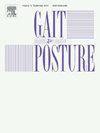腰椎被动刚度可用躯干转动惯量预测
IF 2.2
3区 医学
Q3 NEUROSCIENCES
引用次数: 0
摘要
背景:许多因素已被观察到改变腰椎被动僵硬。然而,是否存在理想的被动刚度水平仍然是未知的。躯干的惯性矩是腰椎屈曲和伸展力矩的决定因素,这些力矩在一个人的活动范围内产生。因此,本研究旨在确定健康年轻人腰椎被动僵硬和躯干惯性矩之间是否存在关系。方法:使用被动式夹具对28名参与者腰椎的被动式刚度进行量化。躯干的转动惯量是根据人体测量测量来计算的。研究发现,参与者的躯干惯性矩与屈曲过渡区和高刚度区的刚度之间存在显著关系,观察到躯干惯性矩较高的个体具有较高的腰椎被动刚度。这些发现表明,一个人的躯干惯性矩可能与腰椎的被动僵硬有关,而一个人的腰椎被动僵硬可能是自然发生的,并与稳定躯干所需的反矩成正比。此外,如果惯性矩和被动僵硬之间存在差异,它提出了一种新的途径来研究作为一个人腰痛和/或损伤风险的可能预测因素。本文章由计算机程序翻译,如有差异,请以英文原文为准。
Lumbar spine passive stiffness can be predicted using trunk moment of inertia
Background:
Many factors have been observed to change lumbar spine passive stiffness. However, it remains unknown if an ideal level of passive stiffness exists. The trunk’s moment of inertia is a determining factor to lumbar spine flexion and extension moments that are produced across one’s range of motion. Therefore, this investigation aimed to determine if a relationship exists between lumbar spine passive stiffness and the trunk’s moment of inertia in healthy young individuals.
Methods:
The passive stiffness of the lumbar spine was quantified in twenty-eight participants using a passive jig. The trunk’s moment of inertia was calculated according to anthropometric measures.
Findings
A significant relationship was observed between participants’ trunk moment of inertia and the stiffness within the transition and high stiffness zones in flexion, with individuals with a higher trunk moment of inertia being observed to have a higher lumbar spine passive stiffness.
Interpretation
These findings suggest that one’s trunk moment of inertia may be related to the passive stiffness of their lumbar spine and that one’s lumbar spine passive stiffness may be naturally occurring and be proportional to the counter-moments that are required to stabilize the trunk. Furthermore, it presents a novel avenue to be investigated as a possible predictor of one’s risk of low back pain and/or injury if discrepancies between moment of inertia and passive stiffness exist.
求助全文
通过发布文献求助,成功后即可免费获取论文全文。
去求助
来源期刊

Gait & posture
医学-神经科学
CiteScore
4.70
自引率
12.50%
发文量
616
审稿时长
6 months
期刊介绍:
Gait & Posture is a vehicle for the publication of up-to-date basic and clinical research on all aspects of locomotion and balance.
The topics covered include: Techniques for the measurement of gait and posture, and the standardization of results presentation; Studies of normal and pathological gait; Treatment of gait and postural abnormalities; Biomechanical and theoretical approaches to gait and posture; Mathematical models of joint and muscle mechanics; Neurological and musculoskeletal function in gait and posture; The evolution of upright posture and bipedal locomotion; Adaptations of carrying loads, walking on uneven surfaces, climbing stairs etc; spinal biomechanics only if they are directly related to gait and/or posture and are of general interest to our readers; The effect of aging and development on gait and posture; Psychological and cultural aspects of gait; Patient education.
 求助内容:
求助内容: 应助结果提醒方式:
应助结果提醒方式:


